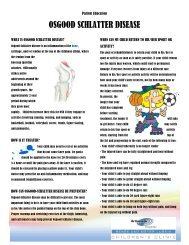“It's A Bargain” Thrift Shop - Orthopaedic Hospital
“It's A Bargain” Thrift Shop - Orthopaedic Hospital
“It's A Bargain” Thrift Shop - Orthopaedic Hospital
Create successful ePaper yourself
Turn your PDF publications into a flip-book with our unique Google optimized e-Paper software.
22<br />
appliances are likely to cause a problem — and<br />
when it does cause a problem, determine which<br />
appliance to use in revision surgery so that the<br />
person can have a better life.<br />
In this case we have no developmental<br />
biologist, but we do have an immunologist to<br />
help us understand how the human immune<br />
response is responding to our taking or not taking<br />
care of the problem.<br />
Previously, if this issue were left up to the<br />
orthopaedic surgeon, the outcome might not be<br />
ideal. He doesn’t know immunology and doesn’t<br />
know about vitamin D. Our premise is that you<br />
have to be able to accumulate expertise from<br />
various different areas and that follows the biology<br />
or the pathology.<br />
motion: Are there other areas you’re exploring?<br />
Dr. Adams: I can give you plenty more, but problems<br />
related to osteoporosis and osteoarthritis<br />
with hip replacement are the major endeavors.<br />
It’s estimated that by 2015, all baby boomers<br />
will be in the high-risk age group. Upwards of<br />
30% to 40% of our population will have low<br />
bone mass or osteoporosis.<br />
You can look at two neighbors and say that<br />
among the three of us, one of us for sure is going<br />
to have a hip fracture, if we live long enough.<br />
And we’re likely to live long enough because we<br />
have better medicines to prevent heart disease<br />
and help people to live longer with cancer.<br />
So, that’s the approach. It’s a novel approach<br />
for orthopaedic surgery because it’s not just<br />
repairing a problem after it’s already been manifest.<br />
We can do things to prevent the problem<br />
from occurring even during adult life. Then<br />
there are issues that we can bring into play that<br />
we didn’t know before that would enable us to<br />
help the orthopaedic surgeon more effectively<br />
deal with this problem.<br />
Also, there are issues at the beginning of life<br />
that we can address — if we can figure out the<br />
genetic background for some of these diseases.<br />
The two that I’ve talked about — osteoporosis<br />
and osteoarthritis — are genetic diseases. If you<br />
ask your parents whether they have lost height<br />
or broken a wrist or hip, you could pretty much<br />
put yourself in that ballpark as being likely to<br />
research<br />
repeat exactly the phenotype of your parents.<br />
Remember, almost 85% of your peak bone mass<br />
is genetically determined.<br />
motion: This interdisciplinary approach you’ve<br />
described might be difficult to achieve in most<br />
places. But the Orthopædic <strong>Hospital</strong> Research<br />
Center seems well positioned within the UCLA<br />
Court of Sciences to take advantage of crosspollination.<br />
Dr. Adams: It’s true. In this building, our near<br />
neighbors are the stem cell researchers and the<br />
new department of molecular-cellular developmental<br />
biology. This building directly across<br />
from us is the nanotechnology institute. A lot<br />
of the scaffolds, the things that we would make<br />
on a nano scale to keep bone cells happy, could<br />
be developed over there.<br />
We anticipate that upstairs in the Orthopædic<br />
<strong>Hospital</strong> Research Center, we will have a raft of<br />
stem cell biologists interacting with the Stem<br />
Cell Institute and the developmental biologists<br />
to figure out how to make bone that stays alive<br />
and regenerates itself.<br />
We also expect to have bioengineers upstairs<br />
who will be able to create the scaffolds that will<br />
be needed to either repair a fracture that isn’t<br />
healing normally or fill a bone defect or make<br />
a hip prosthesis stick better so it won’t move<br />
around and have to be replaced. All of these



